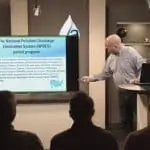

Stormwater Regulation is evolving, pushing more responsibility on to the dischargers by holding them accountable through categorization based on a discharger’s ability to meet numeric benchmarks. Additionally, how a discharger responds and applies effective BMPs determines their status. Ultimately, it is up to the industrial permittee to take the initiative, with an eye to priorities and feasibility for the future of their stormwater compliance program.
Stormwater managers and facility compliance personnel have only just begun to come to terms with the tiered ERA Response paradigm. However, as the tiered escalation becomes more common and ERA Level 1 and Level 2 reporting is performed, facilities are beginning to reach an equilibrium of stormwater compliance in terms of strategy, feasibility, budget and allocation of resources.

In his whitepaper, Jonathan Meronek, QISP, ToR, takes readers through the fundamental components of the ERA, Exceedance Response Action, or tiered Corrective Action compliance mechanism already in place, and currently being implemented in the States of California, Washington and the most recent General Permit in Oregon. ERA has wide-reaching implications for future NPDES permittees of industrial stormwater discharges. The escalation or “tiered” response standards is based on EPA Benchmark Levels and potential for future Numeric Effluent Limits (NELs). The three western states are viewed as “precursors” of what may be expected throughout the United States, as several key components of the forthcoming Multi-Sector General Permit (MSGP) will push other states to move towards similar ERA response scenarios and regulations.
The new Exceedance Response Action (ERA) paradigm has wide-reaching implications for future NPDES permittees of industrial stormwater discharges. This growing regulatory compliance mechanism is already being implemented in California, Washington, and most recently in Oregon. These states are viewed as precursors of future trends throughout the United States, as several key components of the forthcoming Multi-Sector General Permit (MSGP) will influence other states to move toward similar ERA response scenarios and regulations.
Join Forester University for this live, educational, two-part webinar as speaker Jonathan Meronek, QISP ToR, CPESC, QSDP/D, of SCS Engineers discusses the future of the tiered ERA paradigm and why stormwater managers and facility compliance personnel have only begun to come to terms with it. He will help you better understand if your site is covered and how an Industrial Permittee can come into compliance.
The webinar will examine past lessons, including the implementation of effective best management practices, water quality characterizations, and successful compliance strategies. It will also project what the compliance paradigm will look like during the first years of an industrial General NPDES Permit.
Attendees can expect to learn to:
Attendees can expect to earn credits: 2 PDH / 0.2 CEU